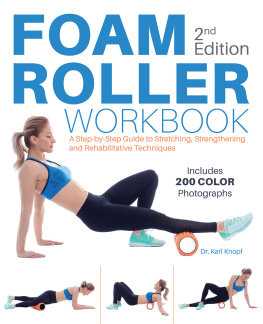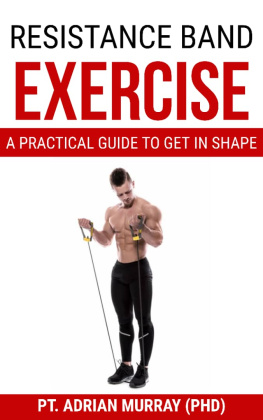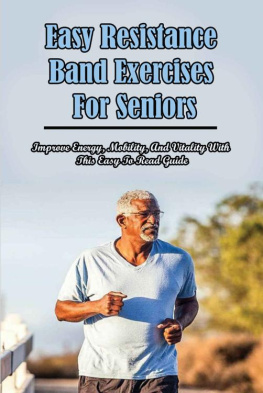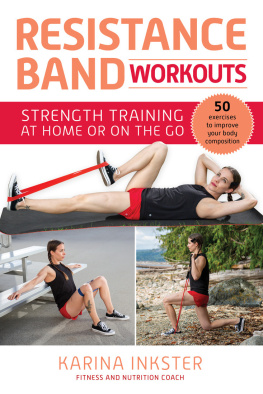
Text copyright 2015 Karl Knopf. Photographs copyright 2015 Rapt Productions except as noted below. Design and concept copyright 2015 Ulysses Press and its licensors. All rights reserved. Any unauthorized duplication in whole or in part or dissemination of this edition by any means (including but not limited to photocopying, electronic devices, digital versions, and the Internet) will be prosecuted to the fullest extent of the law.
Published in the United States by
Ulysses Press
P.O. Box 3440
Berkeley, CA 94703
www.ulyssespress.com
ISBN: 978-1-61243-471-1
Library of Congress Control Number 2014952007
10 9 8 7 6 5 4 3 2 1
Acquisitions: Kelly Reed
Managing editor: Claire Chun
Project editor: Lindsay Tamura
Editor: Lily Chou
Proofreader: Renee Rutledge
Indexer: Sayre Van Young
Front cover/interior design: what!design @ whatweb.com
Front cover photographs: woman Doruk Sikman/shutterstock.com; starburst FMStox/shutterstock.com
Back cover photographs: Rapt Productions
Models: Bryan Ausinheiler, Caitlin Halferty, Toni Silver
Make-Up: SabrinaFosterMakeup.com
Distributed by Publishers Group West
Please Note: This book has been written and published strictly for informational purposes, and in no way should be used as a substitute for consultation with health care professionals. You should not consider educational material herein to be the practice of medicine or to replace consultation with a physician or other medical practitioner. The author and publisher are providing you with information in this work so that you can have the knowledge and can choose, at your own risk, to act on that knowledge. The author and publisher also urge all readers to be aware of their health status and to consult health care professionals before beginning any health program.
This book is independently authored and published. No sponsorship or endorsement of this book by, and no affiliation with any trademarked brands or products mentioned or pictured, is claimed or suggested. All trademarks that appear in this book belong to their respective owners and are used here for informational purposes only. The author and publisher encourage readers to patronize the quality brands and other products mentioned and pictured in this book.
CONTENTS

The world of health and fitness is a complex one. Since lack of exercise contributes to diabetes, high blood pressure and other assorted sedentary health concerns, were told to exercise, but too much exercise causes overstress and injury to our joints and muscles. Additionally, while exercise can make us feel high, too much can bring us pain and soreness.
The answer is to train smart. When you hurt, know when to back off and use corrective exercises. Today, doctors understand the importance of both passive therapies and rehabilitative exercise. While medical science continues to make great advances in surgical and pharmacologic treatments, exercise physiologists are also proving that simple interventions such as proper body mechanics and corrective exercise can play a significant role in decreasing the incidence and severity of arthritis and orthopedic injuries.
One of the goals of rehabilitation today is functional fitness, in which the expected outcome is to maximize the potential for full return of pre-injury status and minimize the chance of re-injury. Just having big arm muscles doesnt mean youre able to throw a ball long and hard. Functional fitness means being fit for your desired activities.
Exercise bands are marvelous corrective-exercise tools with which to rehab a condition. Theyre also inexpensive, portable and very adaptable, available in a range of intensities. Almost any condition can benefit from using resistance bandsits not uncommon to see physical therapists engage clients in the usage of bands. Even major-league pitchers have an assortment of bands hanging in the bullpen to be used for warm-up.
In this book youll find basic information about many common conditions and some corrective exercises that are often used in a rehab setting. While this book is not intended to replace medical advice, I hope that your health provider will use it as a guide to help you facilitate your recovery. The philosophy of this book is that knowledge is power, and the more you know about your condition, the more youll be an equal partner in your health care. Not every exercise in this book is perfect for everyone. However, these exercises have stood the test of time and are considered evidence-based exercises. If you choose to start performing the exercises in this book without medical input, start slowly and monitor how you feel. If you feel worse two hours post-exercise, back off and dont mask pain with overuse of medications.

Prior to World War II, a physical therapy prescription was often considered complete when all it mentioned was heat, rest and massage. Rehabilitation meant little more than passive rest and range-of-motion exercises facilitated by the therapist. Old-school rehab often just worked on the injured part of the body and neglected the others. If exercise was even prescribed it was only listed vaguely.
However, during World War II a revolution of sorts occurred in the field of physical medicine, and therapeutic exercise began to gain acceptance. Physicians began to increasingly become aware of the role that corrective exercise could play in fully restoring soldiers to complete function.
In the 1970s, Dr. Ken Cooper and other exercise physiologists showed how proper regular exercise can be both a preventive tool for better health and a rehabilitation tool for improved function. Today, rehabilitation is not about rest but rather active rehabilitation that integrates both passive and active measures.
Current research continues to show that regular prudent physical activity when preformed in a consistent manner is both healthful and beneficial to quality and quantity of life. In simple terms, if its physical, its therapeutic! Many of the protocols learned from the field of sports medicine to prepare elite athletes for competition and to return them to the playing field are now available to all of us. The current concept in therapy is to involve a total restoration of the system, which is sometimes called a mind-body approach.
To improve strength, all you need to do is apply resistance to the muscle. As the muscle adapts to that load, challenge it again with more resistance. Thus, the proper term for strength training is progressive load. Theres an old myth in which a Greek god started lifting a baby cow every day; as the cow grew in size and weight, his muscles adapted to the load and he developed great amounts of strength. Today, we dont need to lift a cow to improve strength. We have a variety of equipment available to do so, including barbells, dumbbells, machines, exercise bands and even our own body weight.
For the purpose of therapy, however, resistance bands are often preferred. Theyre the perfect tool for rehab since theyre light, easy to adjust and add resistance in multiple directions. Their adaptability and versatility also make them suitable for all levels. Additionally, resistance bands are not only inexpensive, theyre very portable and can be carried and used anywhere. A set of exercise bands that ranges in intensity from super easy to extremely hard can fit in a small bag.
Next page








